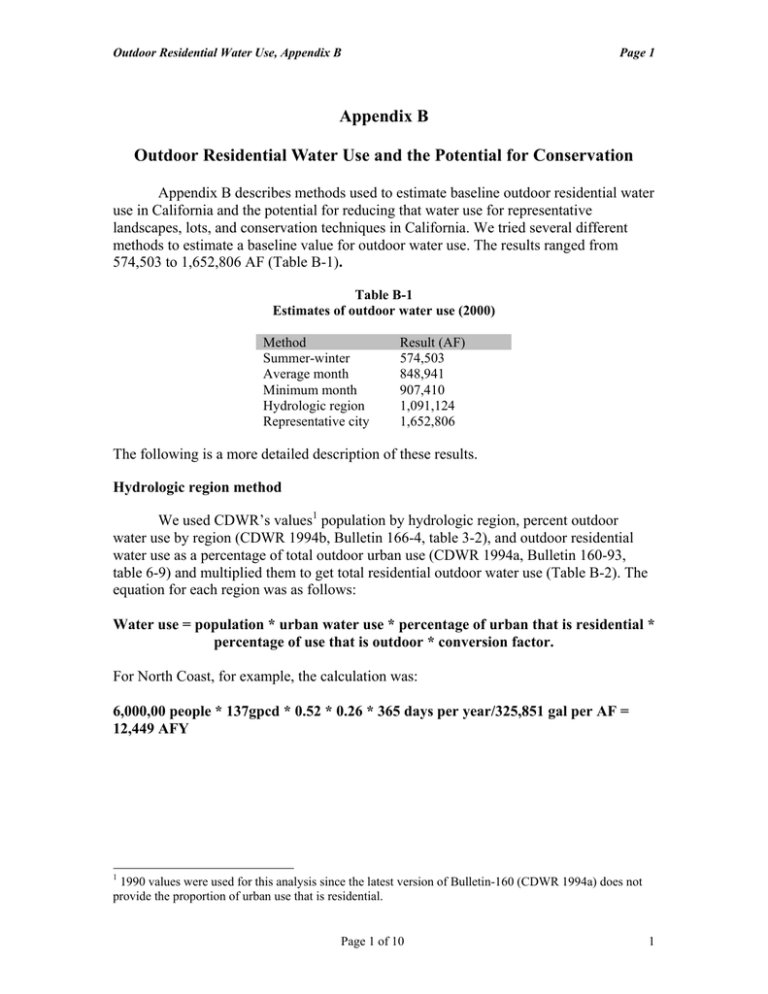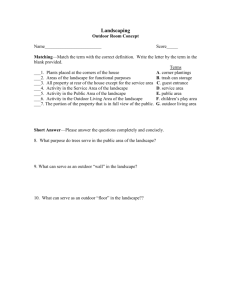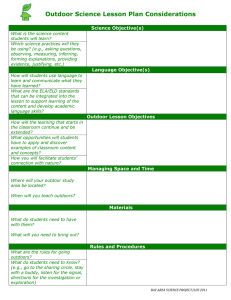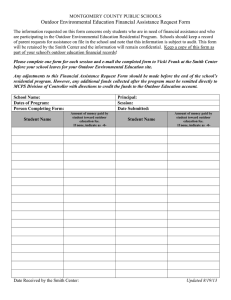Outdoor Residential Water Use and the Potential for Conservation
advertisement

Outdoor Residential Water Use, Appendix B Page 1 Appendix B Outdoor Residential Water Use and the Potential for Conservation Appendix B describes methods used to estimate baseline outdoor residential water use in California and the potential for reducing that water use for representative landscapes, lots, and conservation techniques in California. We tried several different methods to estimate a baseline value for outdoor water use. The results ranged from 574,503 to 1,652,806 AF (Table B-1). Table B-1 Estimates of outdoor water use (2000) Method Summer-winter Average month Minimum month Hydrologic region Representative city Result (AF) 574,503 848,941 907,410 1,091,124 1,652,806 The following is a more detailed description of these results. Hydrologic region method We used CDWR’s values1 population by hydrologic region, percent outdoor water use by region (CDWR 1994b, Bulletin 166-4, table 3-2), and outdoor residential water use as a percentage of total outdoor urban use (CDWR 1994a, Bulletin 160-93, table 6-9) and multiplied them to get total residential outdoor water use (Table B-2). The equation for each region was as follows: Water use = population * urban water use * percentage of urban that is residential * percentage of use that is outdoor * conversion factor. For North Coast, for example, the calculation was: 6,000,00 people * 137gpcd * 0.52 * 0.26 * 365 days per year/325,851 gal per AF = 12,449 AFY 1 1990 values were used for this analysis since the latest version of Bulletin-160 (CDWR 1994a) does not provide the proportion of urban use that is residential. Page 1 of 10 1 Outdoor Residential Water Use, Appendix B Page 2 Table B-2 Estimating Outdoor Water Use: Hydrologic Region Method Hydrologic Region Population Percentage Percentage of (millions) of Use that Urban Use that is Outdoor2 is Residential3 North Coast 0.6 26 52 San Francisco 5.5 26 54.9 Central Coast 1.3 39 60 South Coast 16.3 34 59 Sacramento River 2.2 56 56 San Joaquin River 1.4 58 70 Tulare Lake 1.5 54 67 North Lahontan 0.1 26 38 South Lahontan 0.6 56 63 Colorado River 0.5 54 58 30 Total Water Use (gpcd)4 137 106 112 124 169 216 202 160 175 336 Total Residential Outdoor use AFY 12,449 93,215 38,164 454,165 130,605 137,525 122,796 1,771 41,495 58,939 1,091,124 The next three methods were based on water use data by month and the assumption that residential use accounts for about 57 percent of urban use, both from Bulletin 166-4. These data are shown in Tables B-3 to B-5. Table B-3 Bulletin 166-4 Water Use Data Month January February March April May June July August September October November December Total Days per month 31 28.25 31 30 31 30 31 31 30 31 30 31 Total Urban Water Use gpcd gpcm 145 2,562 150 2,415 170 3,004 180 3,078 205 3,622 225 3,848 250 4,418 245 4,329 225 3,848 200 3,534 160 2,736 150 2,651 Summer-winter method Another method for estimating outdoor use is the “summer-winter” approach. Using CDWR’s Bulletin 166-4 estimates of average gallons per capita per day, we calculated monthly use. Our estimate was then based on the assumption that the 2 B166-4 p.24, table3-2 table 6-9 B160-93 4 b160-93 table 6-8 3 Page 2 of 10 2 Outdoor Residential Water Use, Appendix B Page 3 difference between winter (October through March) and summer (April through September) use was approximately equal to outdoor use. This assumption is supported by Skeel and Lucas (1998) who found that for single-family homes in Seattle, outdoor water use made up more than 95 percent of the observed increase in peak summer consumption. Eighty-five percent of this increase was due to landscape irrigation and less than 5 percent resulted from a slight increase in indoor use in summer months. For example, for January the calculation was: Water use = 31days * 145gpcd * 0.57 * 30,000,000 people/325,851 gallons per AF = 235,888 AF We found the difference between summer and winter use, which we used as the estimate for total outdoor use, to be 574,503 AF. These results indicate that outdoor use accounts for about 16 percent of total use and 27 percent of summer use. Both the outdoor use value and percentage are somewhat lower than what we expected, based on experience and the literature reviewed. Part of the reason for the low result may be that homeowners in some regions do irrigate between October and March. By assuming that all of the October through March water use is for indoor purposes we are likely inflating indoor water use and underestimating outdoor use. Minimum month method We used the same Bulletin 166-4 data as the second method, calculated monthly water use and applied a minimum month methodology. In this approach, the lowest-use month (January) was assumed to represent indoor use and all differences between the other months and the January value were considered to be outdoor use. We aggregated these differences to determine a value for total outdoor use. This method is based on the assumption that indoor use remains fairly consistent across seasons and therefore provides a reasonable estimate of annual indoor demand. This assumption was tested by the REUWS (Mayer et al. 1999), which found that, except for the Tampa site, there were no significant differences in indoor use during different seasons. For the minimum month method we assumed that January, the lowest use month at 145 gpcd, represents indoor use. The difference between January use and water use all other months, calculated on a month-per-month basis (Table B-4), then represents outdoor use. These differences were calculated, summed and multiplied by the current population to yield a result of 907,410 AF. This value indicates that approximately 25 percent of total use or 43 percent of summer use is for outdoor purposes. Table B-4 Estimating outdoor water use: Summer winter, Minimum month, and Average month methods Month January February Days per month 31 28.25 Total Urban Water Use gpcd gpcm 145 2,562 150 2,415 Outdoor water use Minimum month method Average month method gpcd AF (statewide) gpcd AF (statewide) 0 0 5 7,413 2 2,471 Page 3 of 10 3 Outdoor Residential Water Use, Appendix B March April May June July August September October November December Total 31 30 31 30 31 31 30 31 30 31 170 180 205 225 250 245 225 200 160 150 Page 4 3,004 3,078 3,622 3,848 4,418 4,329 3,848 3,534 2,736 2,651 25 35 60 80 105 100 80 55 15 5 40,670 55,102 97,609 125,947 170,816 162,682 125,947 89,475 23,615 8,134 907,410 22 32 57 77 102 97 77 52 12 2 35,248 49,854 92,186 120,699 165,393 157,259 120,699 84,052 18,367 2,711 848,941 Average month method For the average month method we used the average of the three lowest water use months, December to February, rather than the minimum month used in the previous method, to represent indoor use (also in Table B-4). The result we obtained was total outdoor use of 848,941 AF. We assume that it is somewhat lower than the minimum month result for the same reason that the summer-winter month result was low. There may be some outdoor use during the winter period that gets lost as indoor use, thereby bringing down the outdoor use value. Representative city method For the Representative city method we used data CDWR had collected from 20 cities across the state (Table B-5). The data available from CDWR includes the percentage of urban use that is outdoor (Matyac, personal communications, 2000) and that is residential (CDWR 1994a, Table 6-9), population by hydrologic region and city (CDWR 1994a, Table 4-1), and per capita urban water use (CDWR 1994a, Table 4-8). The population of the representative cities adds up to about one-third of the state’s population, we used the water use statistics for these cities as proxies for water use by hydrologic region. There were cases where, within a hydrologic region, water use and the percentage used outdoors for the representative cities were considerably different. For example, in the San Francisco region water use ranges from 132 to 196 gpcd and the proportion used outdoors ranges from 19 to 34 percent, almost double. To account for these differences within hydrologic regions we weighted the populations of the individual cities. Water use for each hydrologic region was calculated as follows: Water use for region = [Σ (city population/sum of populations) * hydrologic region population * water use by city * percent outdoor * percent urban] * conversion factor For the San Francisco Bay region, for example, the calculation was as follows: Population of San Francisco Bay hydrologic region = 5,500,000 Page 4 of 10 4 Outdoor Residential Water Use, Appendix B Page 5 Population of representative cities within the region = 1,200,000+170,000+723,959 = 2,093,959 Water use for the San Francisco Region = [(1,200,000/2,093,959*5,500,000*196*0.55*0.34) + (170,000/2,093,959*5,500,000*153*0.55*0.46) + (723,959/2,093,959*5,500,000*113296*0.55*0.19)]*365/325,851 = 179,005 AFY Using the representative city method, total outdoor water use for the state in 1990 was estimated to be 1,652,806 AF (Table B-5). This value may be somewhat high — we contacted a number of the representative cities and found that their water use figures were lower than those provided by CDWR by up to 27 percent.5 5 For more information and a comparison of the values that we obtained with CDWR’s estimates see: Gleick, P. H. and D. Haasz (1998). Page 5 of 10 5 Salinas Santa Barbara Blythe El Centro Santa Rosa South Lake Tahoe Chico Sacramento EBMUD Marin San Francisco Merced Stockton Los Angeles San Bernadino San Diego County Ridgedrest Victorville Fresno Visalia Total City 296 290 196 153 132 187 336 180 269 196 247 340 273 285 South Lahontan South Lahontan Tulare Lake Tulare Lake Urban water use in gpcd 153 177 349 221 156 179 Sacramento River Sacramento River San Francisco Bay San Francisco Bay San Francisco Bay San Joaquin River San Joaquin River South Coast South Coast South Coast Central Coast Central Coast Colorado River Colorado River North Coast North Lahontan Hydrologic region Outdoor Residential Water Use, Appendix B 63 64 60 61 59 53 34 45 19 65 52 35 50 35 Percent of use that is outdoor 40 38 63 47 46 48 Page 6 of 10 63 63 67 67 56 56 55 55 55 70 70 59 59 59 60 60 58 58 52 38 Percent of use that is residential 1,500,000 500,000 16,300,000 1,400,000 5,500,000 2,200,000 600,000 100,000 500,000 Pop. by hydrologic region 1,300,000 Table B-5 Estimating outdoor water use: By city 28,295 40,674 354,091 75,659 9,990,382 39,970 369,365 1,200,000 170,000 723,959 56,155 210,943 3,485,557 164,676 2,700,000 108,777 85,571 8,448 31,405 113,261 21,586 Pop. by city Page 6 205,128 294,872 1,235,920 264,080 29,334,847 214,822 1,985,178 3,151,924 446,523 1,901,553 294,338 1,105,662 8,946,850 422,696 6,930,454 727,613 572,387 105,990 394,010 113,261 21,586 Weighted population 22,698 45,522 151,601 34,330 1,652,806 23,714 191,042 130,857 18,860 29,270 28,165 152,624 368,986 37,516 314,204 30,181 25,913 15,031 26,745 4,752 796 Water use in AFY 6 Outdoor Residential Water Use, Appendix B Page 7 Outdoor Residential Water Savings: Method Using Representative Lots and Climates Landscape water use and savings from irrigating more efficiently are tricky to estimate because of all the unknowns and data limitations, described in the full report in Section 3, which provides statewide estimates of potential savings. To evaluate the economic feasibility of the options, we needed to look at concrete scenarios that could be discretely priced. It was not realistic to try and price each of the different options at a statewide level. Instead, we developed “representative” landscapes from which we could estimate water use, potential savings, and associated costs. The idea was for these landscapes to capture representative lots in terms of landscape (size, turf area, etc.) and climate conditions around California. Climate conditions vary from cool and moist in the north and coastal areas to hot and arid conditions in the south and Central Valley regions. Precipitation data and landscape requirements by climate type are available through CIMIS and a variety of other sources. The structure of our representative landscapes is based on a set of highquality landscape data from the East Bay Municipal Utility District’s (EBMUD) 1995 Water Conservation Baseline Study and from information on climates and lot sizes around the state. Opitz and Hauer (1995), for example, provide information about landscape and irrigation system characteristics, broken down to reflect differences between the eastern and western parts of the EBMUD service area (Table B-6). The two areas have important socioeconomic (the area east of the hills tends to have higher incomes and larger homes) and physical (the east has a warmer and drier climate than the area west of the hills) differences. In constructing the representative landscapes our goal was to establish a relationship between lot size, area (potentially and actually) landscaped, turf area, and irrigated area. We constructed a typical “small” lot based on a cooler, more humid climate, and a “large” lot based on a warmer, more arid climate to see if, and how, these factors varied. Then we calculated the irrigation requirements and potential savings for these different landscapes and climates. Table B-6: Sample landscape characteristics for single-family homes served by EBMUD Lot Characteristics (ft2) Complete Survey East West 9,500 3,727 5,696 2,513 987 39 60 44 17 39 19,952 5,419 14,533 5,184 1,628 27 73 36 11 31 5,612 3,121 2,481 1,459 727 56 44 59 29 50 Total lot size Hardscape Area Landscape area Irrigated area Turf area Percentage of lot that is hardscape Percentage of lot that is landscape Percentage of landscape that is irrigated Percentage of landscape that is turf Percentage of irrigated area that is turf Source: Opitz and Hauer 1995 The east-side lots are about 3.5 times larger than those on the west side but the hardscape (including the building footprint) area is only about 60 percent larger. The Page 7 of 10 7 Outdoor Residential Water Use, Appendix B Page 8 east-side sites have a larger proportion of their lot landscaped; about 73 percent of the lot compared with about 44 percent on the west side. The east-side homes irrigate only 60 percent as much of their landscape and have about one-third the proportion of turf as do the west side homes, but their average turf and irrigated areas is larger because of the difference in average lot size. On average, the east-side homes irrigate about 5,184 ft2 and have 1,628 ft2 of turf while west-side homes irrigate about 1,459 ft2 and have 727 ft2 of turf. From this information, we constructed two representative landscapes: Large landscape: Lot size: 19,950 ft2 Landscape area: 14,530 ft2 Irrigated area: 5,180 ft2 Turf area: 1,630 Small Landscape: Lot size: 5,610 ft2 Landscape area: 2,480 ft2 Irrigated area: 1,459 ft2 Turf area: 727 ft2 The next step was to estimate water use. CIMIS data was used to obtain monthly precipitation and ET information (http://wwwdpla.water.ca.gov/cgibin/cimis/cimis/data/get_data). For the east of the hills site we used data from the Walnut Creek CIMIS station, and for the west-side site we used data from the Oakland foothills station. We calculated the water requirements for all four scenarios, varying landscape size and climate permutations (large landscape coastal and arid climates, small landscape coastal and arid climates). The amount of water required by turf was calculated by multiplying turf acreage by one of three ETo coefficients: 1.3 ETo, the amount of water we estimate is currently being used to irrigate turf; 1.0 ETo, the amount typically recommended; and 0.8 ETo, the amount that could be achieved with proper scheduling. The amount of water used for landscape irrigation was calculated using the following equation: Landscape Water Use (gal/yr) = Required irrigation (in/yr) * ETo * acreage (ft 2 ) 12 in .1337 ft 3 * ft gal ETo is the variable that represents the efficiency with which the landscape is being maintained. CDWR estimates that statewide ETo is about 1.3 for turf (which means that 30 percent more water is applied than is typically recommended) and 1.0 for non-turf (CDWR 1998). We applied these ETo estimates to our representative landscapes to determine baseline use. To determine potential savings we used the same physical landscape and ratio of turf to non-turf but applied lower ETo values. Studies performed across the state and country and our communications with professionals in the field suggest that ETo rates of 0.8 for turf and 0.6 for non-turf were a reasonable target for landscape conservation programs. Our calculations indicate that, depending on the size Page 8 of 10 8 Outdoor Residential Water Use, Appendix B Page 9 and climate conditions of the landscape, anywhere from about 17,000 to 65,000 gallons of water could be saved every year per site (see Table B-7 and the following scenarios). Table B-7: Baseline and potential water use for representative landscapes Water Use (gpy) Baseline Potential Savings Large, Arid 166,877 101,084 65,793 Large, Coastal 147,788 89,521 58,267 Small, Arid 49,341 30,032 19,309 Small, Coastal 43,694 26,595 17,099 Scenario B-1a: Large Landscape, Arid Climate (gallons per year) Jan Feb Irrigation rates---percentage Eto 1 0.8 1 0.6 Turf water use Non-turf water use 1,583 1,218 974 2,660 1,596 1,979 1,522 1,218 3,325 1,995 March April May June 3,825 5,804 7,783 8,706 2,943 4,465 5,987 6,697 2,354 3,572 4,789 5,358 6,428 9,752 13,077 14,628 3,857 5,851 7,846 8,777 July Aug Sept October November Dec Total 9,762 8,442 6,991 4,221 1,979 1,187 62,263 7,509 6,494 5,378 3,247 1,522 913 47,894 6,007 5,195 4,302 2,598 1,218 731 38,315 16,401 14,185 11,747 7,092 3,325 1,995 104,614 9,841 8,511 7,048 4,255 1,995 1,197 62,769 1.3 Water Use (gpy) Current Potential Potential savings 166,877 101,084 65,793 Scenario B-1b: Large landscape, coastal climate (gallons per year) Irrigation rates---percentage Eto 1 0.8 1 0.6 Turf water use Non-turf water use 1,979 1,522 1,218 3,325 1,995 1,979 1,522 1,218 3,325 1,995 1.3 Jan Feb March April May June 3,694 5,145 6,728 6,991 2,841 3,957 5,175 5,378 2,273 3,166 4,140 4,302 6,206 8,644 11,304 11,747 3,724 5,186 6,782 7,048 July Aug 7,915 7,255 6,088 5,581 4,871 4,465 13,298 12,190 7,979 7,314 Page 9 of 10 Water Use (gpy) Current Potential Potential savings 147,787 89,521 58,267 9 Outdoor Residential Water Use, Appendix B Sept October November Dec Total 6,332 4,089 1,847 1,187 55,141 4,871 3,146 1,421 913 42,416 3,896 2,516 1,136 731 33,933 Page 10 10,639 6,871 3,103 1,995 92,647 6,383 4,123 1,862 1,197 55,588 Scenario B-2a: Small landscape, Arid climate (gallons per year) Irrigation rates---percentage Eto 1 0.8 1 0.6 Turf water use Non-turf water use 707 544 435 547 328 884 680 544 684 411 1,708 1,314 1,051 1,323 794 2,592 1,994 1,595 2,007 1,204 Water Use (gpy) 3,475 2,673 2,139 2,692 1,615 Current use 49,341 3,888 2,991 2,393 3,011 1,807 Potential use 30,032 4,359 3,353 2,683 3,376 2,026 Savings 19,309 3,770 2,900 2,320 2,920 1,752 3,122 2,402 1,921 2,418 1,451 1,885 1,450 1,160 1,460 876 884 680 544 684 411 530 408 326 411 246 27,805 21,389 17,111 21,536 12,921 1.3 Jan Feb March April May June July Aug Sept October November Dec Total Scenario B-2b: Small landscape, Coastal climate (gallons per year) Jan Feb March April May June July Aug Sept October November Dec Total Irrigation rates---percentage Eto 1.3 1 0.8 1 0.6 Turf water use Non-turf water use 884 680 544 684 411 884 680 544 684 411 1,649 1,269 1,015 1,277 766 2,297 1,767 1,414 1,779 1,068 Water Use (gpy) 3,004 2,311 1,849 2,327 1,396 Current use 43,694 3,122 2,402 1,921 2,418 1,451 Potential use 26,595 3,534 2,719 2,175 2,737 1,642 Savings 17,099 3,240 2,492 1,994 2,509 1,506 2,828 2,175 1,740 2,190 1,314 1,826 1,405 1,124 1,414 849 825 634 508 639 383 530 408 326 411 246 24,623 18,941 15,153 19,071 11,443 Page 10 of 10 10


